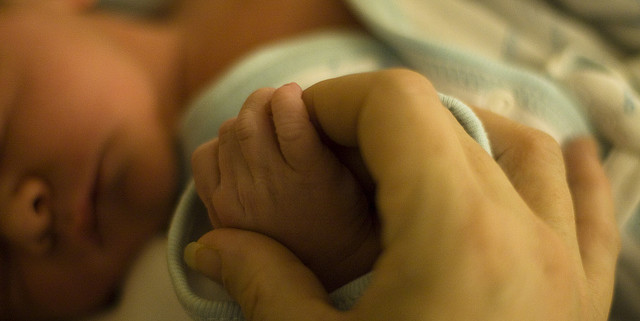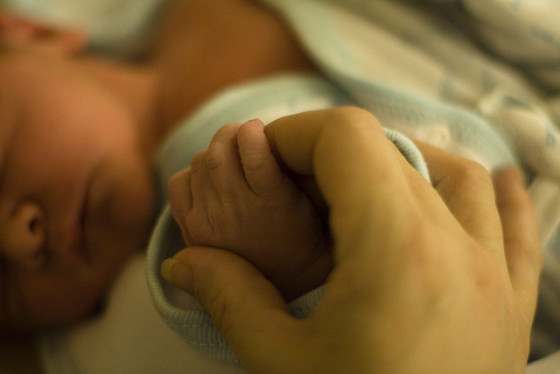Moro Reflex and Apgar Score: Baby’s First Tests
Last updated April 28, 2017.
Most babies are born ready to live on their own outside the womb. Some, however, need a little help. Maybe they were born early or maybe their development is a little slower. Just after delivery, your doctor will perform an assessment of your little one’s health to determine if more medical assistance is going to be necessary to help her adjust to life on the outside. The first tests your little one will ever take are the Apgar (or APGAR) test and the Moro reflex test.
Contents
What is the Apgar test?
Developed in 1952, the Apgar test has been the standard for evaluating newborn physical health for decades. You may see it written as Apgar or APGAR. It’s named for Virginia Apgar, an obstetric anesthesiologist, but also has been turned into an acronym to describe the elements the test checks:
Appearance
Pulse
Grimace
Activity
Respiration
The test is performed at 1 minute after delivery and then again at 5 minutes after delivery. If the baby’s score is low, it may be performed again at later intervals to check on the little one’s progress.
The Apgar Score
The test results in a simple numerical Apgar score between 1 and 10. A score of 7 or higher is considered healthy. Scores between 4 and 7 may require additional medical attention, while scores of 3 or lower are considered critical. Each of the five test elements may receive a score of 0, 1, or 2, and the five scores are added together to find the total.
Appearance
To score a 2, the child must be pink from head to toe, indicating good oxygenation and blood flow. If your little one has blue fingers or toes, that earns a 1. If the baby is blue or pale from head to toe, that’s a score of 0. Almost all babies have blue fingers and toes, so it’s very rare to score a 2 on this element.
Pulse
Healthy babies have a pulse at or above 100 beats per minute. If your little one’s heart rate is slower than that, she’ll score a 1. A score of 0 is assigned if the baby’s heart isn’t beating on its own.
Grimace
This is a test of how the baby responds to stimulation such as a mild pinch or poke. To score a 2, the baby must cry in response to stimulation. A score of 1 will be assigned if the baby grimaces in response to the stimulation and non-responsive babies have a score of 0.
Activity
A healthy baby will squirm and kick right after birth and be able to flex her arms and legs. If the baby’s muscles are weak, she’ll receive a score of 1. A score of 0 will be assigned if the baby doesn’t move.
Respiration
The baby will get a score of 2 for a strong, hearty cry. If the baby’s crying is weak or irregular or if she’s gasping for air, that’s a score of 1. The baby will be assigned a 0 if she’s not breathing on her own.
See also: First Signs of Labor: How to Know When Baby is Coming
What does the Apgar score mean?
An Apgar score over 7 indicates that your baby is healthy and probably won’t need any extra medical attention. Lower scores are often caused by a difficult labor and are more common in babies delivered by Cesarean section, since the vaginal birth process helps stimulate the baby and squeeze fluid out of her lungs. The Apgar score can also be affected by maternal sedation or anesthesia. Babies that are born prematurely may have low muscle tone and difficulty breathing on their own, so they’re also likely to have lower scores.
This test is just an evaluation of how much help the baby needs adjusting to life outside of the womb — it’s a big change! Most babies with low scores at 1 minute will have normal scores at 5 minutes or shortly thereafter. The baby may need to have fluid suctioned out of her airways, receive extra oxygen to help ease the burden on her heart and lungs, and have extra physical stimulation (such as slapping the bottom of the baby’s feet) to get her heart rate up.
Remember that the Apgar score is not meant to predict your baby’s health or ability later in life. It’s just an evaluation of her first adjustment to outside life.
The Moro Reflex
In addition to the Apgar test, your doctor will test your little one’s Moro reflex just after birth. This reflex indicates a healthy nervous system; it’s present from birth until the child reaches 4 or 5 months of age.The test involves putting the baby on a padded surface and lifting the head enough to begin to lift the body. The doctor will then release the baby’s head for a moment to simulate the sensation of falling and catch the baby before she hits the padding.
A healthy Moro reflex will cause the baby to throw her arms up, look startled, and possibly cry; she will then bring her arms back close to her body when the doctor catches her.
In some babies, only one arm will move in response to the falling sensation. This asymmetrical Moro reflex often indicates either a broken collarbone or damage to the brachial plexus nerves.
Some babies have no Moro reflex. This usually indicates damage to the spinal cord or damage to the brain.
Your doctor will continue to test your baby’s Moro reflex at regular wellness visits; it should go away after about 6 months. If it doesn’t go away, it can seriously impact your child’s motor and intellectual development. A persistent Moro reflex may also be an indicator of cerebral palsy, a type of brain damage.
Low Apgar score or no Moro reflex? Ask questions
Childbirth is overwhelming to begin with. On top of that, it can be very scary to have a doctor tell you that your little one has a low Apgar score or abnormal Moro reflex. The key is to ask questions until you’re confident that you understand what the doctor is telling you. These are the very first medical evaluations your little one will have and they’re meant to make sure your child gets the medical support she needs. Talk to your doctor about whether your little one will need additional testing or if there’s anything you should watch out for at home. When it comes to the health of your baby, there’s no such thing as a stupid question.
Image Credit and License









I wanted info on babinski test, startle reflex, and sucking reflex. I know how babinski is done. You take an object that won’t hit the baby but the baby will feel the object go down the bottom of the foot and the foot will react to the sensation. I’ve seen it done, even on older disabled children. But I don’t know how they test the others.
Hurt not hit.
Deborah: This link may help you. http://www.healthline.com/health/parenting/startle-reflex-in-babies